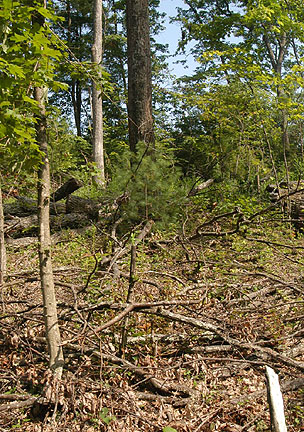
The large white oak in
the center of the photo was left as a reserve tree to provide
shade, acorns for wildlife and very high-value timber at the
end of the next rotation.
|
It is becoming more fashionable today to use modifications
of the shelterwood method called reserve shelterwood, shelterwood
with reserves, or modified shelterwood. With these modifications,
some residual trees are left for long periods of time after the new
forest has become established. The purpose for this is usually for
aesthetics or wildlife food and cover. The trees selected to leave
should be trees that will survive and have the desired characteristics.
For example, if the purpose for leaving the trees is for wildlife
food, trees that produce nuts or soft mast should be left. Oaks, hickories, blackgum,
and cherries would
be good choices. Red
maple and yellow-poplar would
not. If the trees to be left will be harvested for timber at some
future date, trees to be left should be sawtimber size, of desirable
species and quality, and have large, full crowns with no evidence
of epicormic branches. Epicormic branches are small, side branches
that are found on some hardwood trees, generally those with weak
crowns. White oak is notorious for producing large numbers of epicormic
branches. These side branches reduce the quality and value of the
tree, and thus are not desirable. |